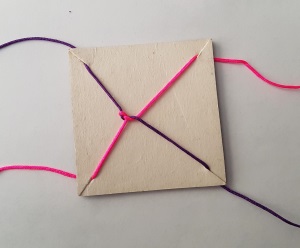Or search by topic
Number and algebra
Geometry and measure
Probability and statistics
Working mathematically
For younger learners
Advanced mathematics
Twisting and Turning
Age 11 to 14
Challenge Level 





- Problem
- Getting Started
- Student Solutions
- Teachers' Resources
Why do this problem?
This problem introduces an intriguing trick which provides a context for practising manipulation of fractions. Watching the video, or perhaps trying the trick out for themselves, can engage students' curiosity, and lead to some intriguing mathematics to explore and explain.Possible approach
Show the video in the problem, and explain the two functions:Twisting has the effect of adding 1: $$x \mapsto x+1$$
Turning transforms any number into the negative of its reciprocal: $$x \mapsto -\frac1x$$
You may wish to pause the video at each stage and invite students to work out what the next fraction will be. Below is a useful table showing the operation and the fraction at each stage of the video.
| Operation | Fraction |
|---|---|
| Twist | $1$ |
| Twist | $2$ |
| Turn | $-\frac12$ |
| Twist | $\frac12$ |
| Twist | $1\frac12$, or $\frac32$ |
| Twist | $2\frac12$, or $\frac52$ |
| Turn | $-\frac25$ |
| Twist | $\frac35$ |
| Twist | $1\frac35$, or $\frac85$ |
| Twist | $2\frac35$, or $\frac{13}5$ |
| Turn | $-\frac5{13}$ |
If students have grasped the two operations, you could challenge them to work out a sequence of twists and turns to get back from $-\frac5{13}$ to $0$. Alternatively, watch the rest of the video to see the surprising moment when the ropes disentangle. Here is the sequence:
| Operation | Fraction |
|---|---|
| Twist | $\frac8{13}$ |
| Turn | $-\frac{13}8$ or $-1\frac58$ |
| Twist | $-\frac58$ |
| Twist | $\frac38$ |
| Turn | $-\frac83$ or $-2\frac23$ |
| Twist | $-\frac53$ or $-1\frac23$ |
| Twist | $-\frac23$ |
| Twist | $\frac13$ |
| Turn | $-3$ |
| Twist | $-2$ |
| Twist | $-1$ |
| Twist | $0$ |
Now that students understand the two operations, set them the challenge in the problem - working out the fraction for each stage of the sequence, and working out the sequence to get back to zero:
Twist, twist, twist, turn, twist, twist, twist, turn, twist, twist, twist, turn
To finish off, students could perform their sequence to tangle and untangle their own set of skipping ropes, before moving on to More Twisting and Turning. Alternatively, they could perform the sequence individually using string and card, as shown below.

Key questions
What fraction do you reach next if you twist?What fraction do you reach next if you turn?
How will you decide whether to twist or turn next?

